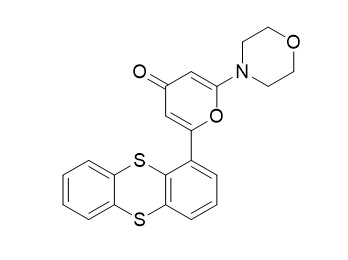KU55933 (ATM Kinase Inhibitor)
KU-55933 (ATM Kinase Inhibitor) is a potent and specific ATM inhibitor with IC50/Ki of 12.9 nM/2.2 nM in cell-free assays, and is highly selective for ATM as compared to DNA-PK, PI3K/PI4K, ATR and mTOR. KU‑55933 (ATM Kinase Inhibitor) inhibits the activation of autophagy‑initiating kinase ULK1 and results in a significant decrease of autophagy.
Inquire / Order:
manager@chemfaces.com
Technical Inquiries:
service@chemfaces.com
Tel:
+86-27-84237783
Fax:
+86-27-84254680
Address:
1 Building, No. 83, CheCheng Rd., Wuhan Economic and Technological Development Zone, Wuhan, Hubei 430056, PRC
Providing storage is as stated on the product vial and the vial is kept tightly sealed, the product can be stored for up to
24 months(2-8C).
Wherever possible, you should prepare and use solutions on the same day. However, if you need to make up stock solutions in advance, we recommend that you store the solution as aliquots in tightly sealed vials at -20C. Generally, these will be useable for up to two weeks. Before use, and prior to opening the vial we recommend that you allow your product to equilibrate to room temperature for at least 1 hour.
Need more advice on solubility, usage and handling? Please email to: service@chemfaces.com
The packaging of the product may have turned upside down during transportation, resulting in the natural compounds adhering to the neck or cap of the vial. take the vial out of its packaging and gently shake to let the compounds fall to the bottom of the vial. for liquid products, centrifuge at 200-500 RPM to gather the liquid at the bottom of the vial. try to avoid loss or contamination during handling.
Molecules.2020, 25(3):734
Agronomy2023, 13(6), 1435.
Antioxidants (Basel).2023, 12(12):2078.
Food Chem.2019, 276:768-775
Research Square2024, rs-4398438
Nutraceutical Research . 2021, 19(1),p90-105.
Asian Journal of Chemistry2018, 30(12):2699-2703
Molecules.2021, 26(6):1635.
Biomed Chromatogr.2022, 36(11):e5462.
Appl. Sci.2025, 15(1), 247
Related and Featured Products
Aging (Albany NY),2011 Aug;3(8):782-93.
Mechanisms of chemotherapy-induced human ovarian aging: double strand DNA breaks and microvascular compromise.[Pubmed:
21869459]
The mechanism of chemotherapy-induced acceleration of ovarian aging is not fully understood.
METHODS AND RESULTS:
We used doxorubicin, a widely used cancer chemotherapeutic, in a variety of in vivo xenograft, and in vitro models to investigate the impact of chemotherapy-induced aging on the human ovary. Doxorubicin caused massive double-strand-DNA-breaks in primordial follicles, oocytes, and granulosa cells in a dose dependent fashion as revealed by accumulating γH2AX foci. This damage was associated with apoptotic oocyte death and resulted in the activation of ATM. It appeared that the repair response enabled a minor proportion of oocytes (34.7%) and granulosa cells (12.1%) to survive while the majority succumbed to apoptotic death. Paradoxically, inhibition of ATM by KU-55933 resulted in improved survival, probably via prevention of downstream activation of TAp63α. Furthermore, doxorubicin caused vascular and stromal damage in the human ovary, which might impair ovarian function both pre- and post-menopausally.
CONCLUSIONS:
Chemotherapy-induced premature ovarian aging appears to result from a complex process involving both the germ- and non-germ cell components of the ovary. These effects may have clinical implications in aging both for premenopausal and postmenopausal cancer survivors.
Cancer Res,2004 Dec 15;64(24):9152-9.
Identification and characterization of a novel and specific inhibitor of the ataxia-telangiectasia mutated kinase ATM.[Pubmed:
15604286]
Cell lines: U2OS cells
Concentrations: 10 μM
Incubation Time: 2 hours
Method:
U2OS cells are exposed to ionizing radiation (3, 5, or 15 Gy) or UV (5 or 50 J/m2) and the ATM response determined by Western blot analysis of p53 serine 15 phosphorylation and stabilization of wild-type p53. Whole cell extracts are obtained from each time point, proteins separated by SDS-PAGE, and the ATM-specific increase in phosphorylated serine 15 measured with a p53 phospho-serine 15 specific antibody. Overall p53 stabilization with time is also observed with a p53-specific antibody (DO-1). Similarly, for studying ATM-dependent phosphorylations on H2AX, CHK1, NBS1, and SMC1, the following antibodies are used: CHK1 phospho-serine 345 and NBS1 phospho-serine 343 antibodies. Histone H2A (H-124) and CHK1 antibodies are also used, as well as SMC1 and SMC1 phospho-serine 966 antibodies. For determination of a cellular IC50 for KU-55933, the peak response time for p53 serine 15 phosphorylation of 2 hours is used to monitor inhibition of ATM. KU-55933 is titrated onto cells and preincubated for 1 hour before ionizing radiation. Using scanning densitometry, the percentage inhibition relative to vehicle control is calculated, and the IC50 value is calculated as for the in vitro determinations.
Cancer Res,2009 Apr 15;69(8):3510-9.
Inhibition of ataxia telangiectasia mutated kinase activity enhances TRAIL-mediated apoptosis in human melanoma cells.[Pubmed:
19351839]
Animal Models: BALB/c nu/nu nude mice bearing LU1205 cells
Dosages: 10 μM
Administration: ---



